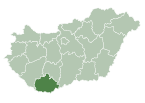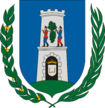Szentlászló
Senglasl (German) | |
|---|---|
Village | |
| Coordinates: 46°09′24″N 17°50′08″E / 46.15667°N 17.83556°E | |
| Country | |
| County | Baranya |
| Originally named Disznóóvó | 1237[1] |
| Government | |
| • Mayor | István Hideg [2] |
| • Notary | Krisztián Kontra |
| Population | |
| • Total | 850 |
| • Density | 156.6/sq mi (60.46/km2) |
| [3] | |
| Time zone | UTC+1 (CET) |
| • Summer (DST) | UTC+2 (CEST) |
| Postcode | 7936 |
| Area code | 73 |
| Website | Website |
Szentlászló is a village in Baranya county, Hungary.
YouTube Encyclopedic
-
1/4Views:8035403 6591 706
-
Szentlászló (1993.)
-
Szentlászló 2010 traktorhúzás
-
Szentlászló dal Eszékről, 1992 - Laslovo/Osijek - Horvátország/Croacia/Hrvatska
-
Szentlászló - a bemutató kisfilm nyers változata (1993.)
Transcription
Location
The village is located on the northwestern side of Baranya (in Zselic). The next city Szigetvár lies 13 km from the village. Baranya's county seat Pécs is 47 km away. There was a MÁV railway between Szigetvár and the second proximate city Kaposvár. Since the 1970s, the only way to come to the village has been the main road numbered 67, and by bus. The through traffic is big, because the trucks going to Lake Balaton drive through.
History
Before the 1950s, Szentlászló was placed in Somogy. The first written sources derive from 1287–1240. The patron saint is Saint Ladislaus I. Here there was a rectory named Margitapuszta. Szentlászló's rectory was given by Ladislaus I. In the Turkish occupation there was no constant population. In the 18th century Germans came to the village. After World War II they deployed to East Germany, and instead of them, came people from Slovakia. The first church was built in 1738. The present church sacred in 1821. The Germans had their own ethnic council, which opened in 2002. The primary school is an ethnic school.
Interesting places
Village museum
The museum is next to the Route 67. In this museum there are some old Kraut clothes, furniture, and other items.
Corn museum
The only corn museum in the country. The museum is like that in Romania. There are puppets, and furniture from the corn's "hair".
King St. Ladiuslaus Primary School
The village's school, with classes 1 to 8 (1–4, and higher 5–8). The school has programs like "German day", football matches, and some other events.
Kindergarten
For the younger generation it has two groups, but too few children. It has a dinner place in the other side, where everybody who demands can eat.
St. Ladislaus Roman Catholic Church
It can be found in a Y-corner next to the school and kindergarten. This church was built in 1821, and was renovated in 2001 because the tower started to fall out in the road.
References
- ^ Dr. Grünwald Géza (1997). Baranya Megye Kézikönyve II (in Hungarian). Bo&Bo, Ceba, Gruppa. p. 313. ISBN 963-9089-00-1.
- ^ "Szentlászló települési választás eredményei" (in Hungarian). Nemzeti Választási Iroda. 2014-10-12. Retrieved 2016-01-22.
- ^ http://portal.ksh.hu/pls/ksh/docs/hun/hnk/Helysegnevkonyv_adattar_2010.xls[dead link]



